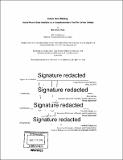| dc.contributor.advisor | Kent Larson and Takehiko Nagakura. | en_US |
| dc.contributor.author | Chen, Nai Chun | en_US |
| dc.contributor.other | Massachusetts Institute of Technology. Department of Architecture. | en_US |
| dc.date.accessioned | 2017-01-12T18:32:26Z | |
| dc.date.available | 2017-01-12T18:32:26Z | |
| dc.date.copyright | 2016 | en_US |
| dc.date.issued | 2016 | en_US |
| dc.identifier.uri | http://hdl.handle.net/1721.1/106414 | |
| dc.description | Thesis: S.M., Massachusetts Institute of Technology, Department of Architecture, 2016. | en_US |
| dc.description | Cataloged from PDF version of thesis. | en_US |
| dc.description | Includes bibliographical references (pages 70-71). | en_US |
| dc.description.abstract | The emergence of "big data" has resulted in a large amount of information documenting daily events, perceptions, thoughts, and emotions of citizens, all annotated with the location and time that they were recorded. This data presents an unprecedented opportunity to help identify and solve urban problems. This thesis aimed to explore the potential of machine learning and data mining in finding patterns in "big" urban data. We explored several different types of user generated urban data, including Call Detail Records (CDR) data and social media (Crunch Base, Yelp, Twitter, and Flickr, and Trip Advisor) data on two primary urban issues. First, we aimed to explore an important 21st century urban problem: how to make successful "Innovative district". Using data mining, we discovered several important characteristics of "innovative districts". Second, we aimed to see if big data is able to help diagnose and alleviate existing problems in cities. For this, we focused on the city of Andorra, and discovered potential reasons for recent declines in tourism in the city. We also discovered that we can learn the travel patterns of tourists to Andorra from their past behavior. In this way, we can predict their future travel plans and help their travels, showing the power of data mining urban data in helping to solve future urban problems as well as diagnose and improve existing problems. | en_US |
| dc.description.statementofresponsibility | by Nai Chun Chen. | en_US |
| dc.format.extent | 71 pages | en_US |
| dc.language.iso | eng | en_US |
| dc.publisher | Massachusetts Institute of Technology | en_US |
| dc.rights | M.I.T. theses are protected by copyright. They may be viewed from this source for any purpose, but reproduction or distribution in any format is prohibited without written permission. See provided URL for inquiries about permission. | en_US |
| dc.rights.uri | http://dspace.mit.edu/handle/1721.1/7582 | en_US |
| dc.subject | Architecture. | en_US |
| dc.title | Urban data mining : social media data analysis as a complementary tool for urban design | en_US |
| dc.title.alternative | Social media data analysis as a complementary tool for urban design | en_US |
| dc.type | Thesis | en_US |
| dc.description.degree | S.M. | en_US |
| dc.contributor.department | Massachusetts Institute of Technology. Department of Architecture | |
| dc.identifier.oclc | 966694133 | en_US |
